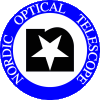Observing with MOSCA
Observing with MOSCA is easy,
however there are a couple of things to be remembered when using MOSCA:
First:
In practice 2 by 2 binning (0.217 arc sec per pixel) is the
default observing mode. However this is set by the observer.
Second: You need to take some dark frames.
Third: You need to take some bias frames between your science frames.
Just before sunset:
• start the CCD control programme
(MOSCA Control Software startup procedure.),
• power on the telescope
(Cookbook:Observing Startup Procedure)
,
• set the field angle to -90
• slew to the blank-field
Twilight:
• take the twilight flat-fields
• focus the telescope ( Focusing MOSCA.)
After twilight:
• slew to your object
• shoot.
Afternoon:
During the afternoon it is recommended to
take some bias frames and *dark* frames.
The dark frames should have
similar or longer integration time as your longest science exposures.
Please let your duty officer known that you taking dark exposures
in order to keep the dome dark.
In addition, it doesn't make any harm to take a set of dome flats
however twilight flats do a
good job as well.
Twilight:
Due to the fast read out of the camera (2x2 binning), in a normal evening
one can easily take 15-20 flat-field frames.
After flat fields focus the telescope, using command
focus3, focus 5 or focus7
Focusing MOSCA.
Focus offsets
Most 100mm filters are about 5mm thick and are expected to have similar
telescope focus values. The estimated focus offset is 19 units per
millimetre, i.e. the estimated focus offset
between filters #108 (I_int 817_163) and #116 (b_Str 468_19) is +19
TCS focus units.
See the thickness of filters
Observing:
In most cases one has more than one pointing per filter per object.
The possibility is to type (all) the commands (exp, object, teloffset) on the
command line (sequencer-window)
and change the filters by clicking on the "FASU User
Interface" or write a script
Unfortunately the bias level of CCD[im4] is variable, hence it is
recommended to take a bias frame every now and then in order to
monitor the bias level changes.
After the commissioning the instrument the top right CCD (W19)
has shown to have variable bias level.
The change of thirty ADUs in 30 minutes have been seen.
This behaviour is under investigation. The other
CCDs have shown little (a few ADUs) or no intra-night bias level changes.
Note that the "quickexam" FWHM values are unbinned pixel units, i.e.
FWHM=7.8 pixels corresponds 0.8 arc-seconds.
Teloffset:
Offsets the telescope in seconds of arc in detector x and y direction,
e.g. if you want to move a star from the centre of the FOV (the cross) to
the centre of the bottom left hand CCD do "teloffset -120 -120". Note that teloffset works with any field angle.
MOSCA trouble shooting
MOSCA Control Software startup procedure.
MOSCA scripts
StanCam and MOSCA together
|
